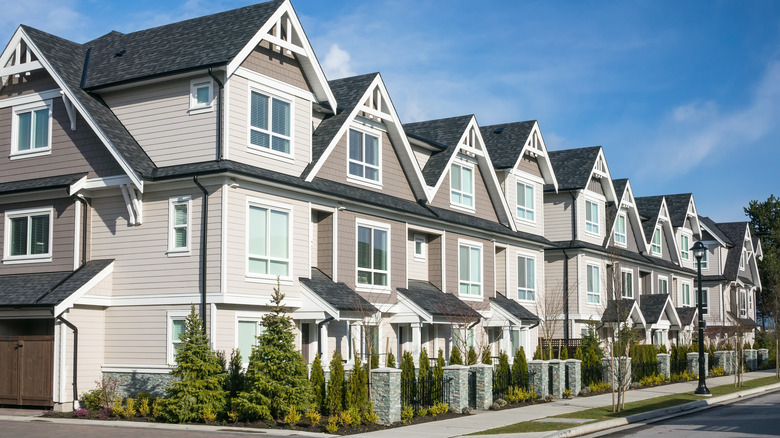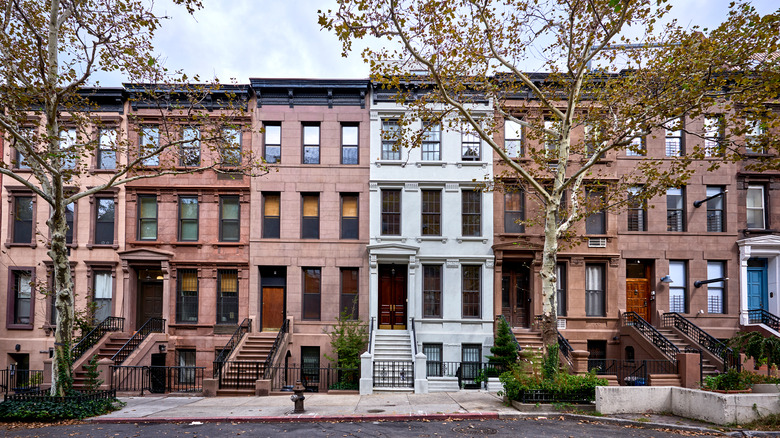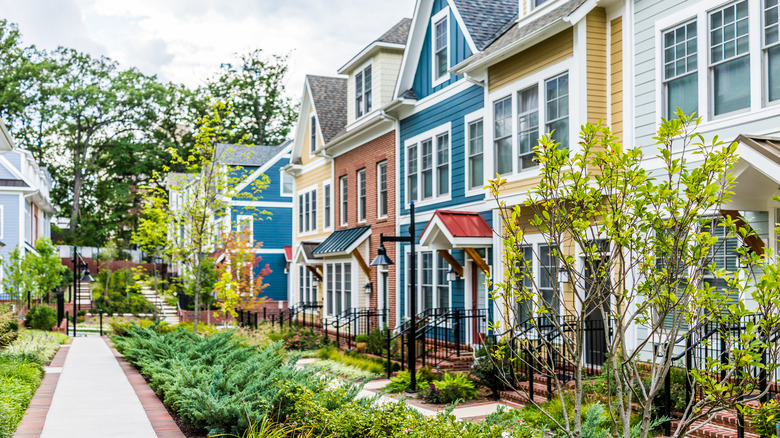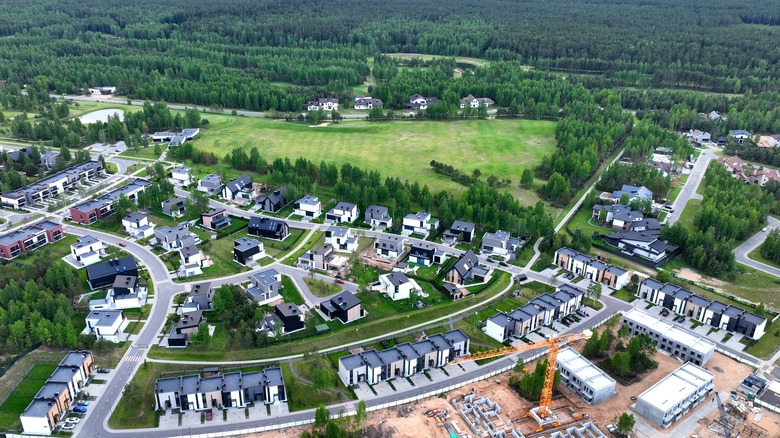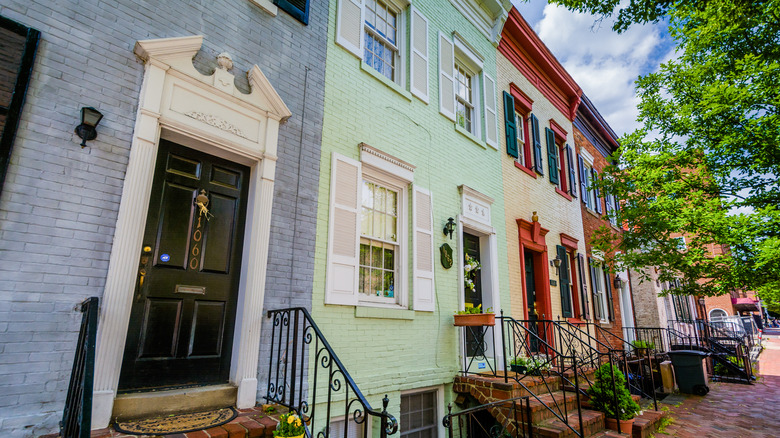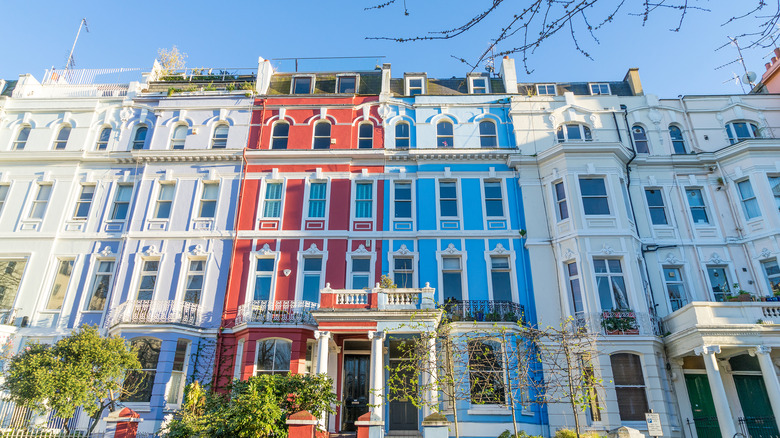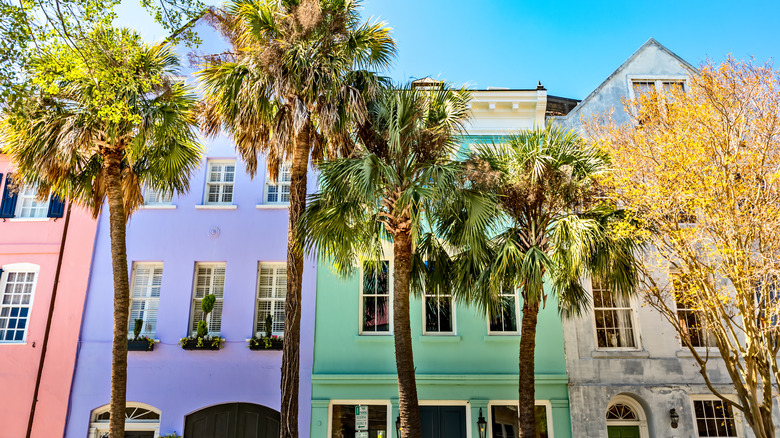Rowhouse Vs Townhouse: What's The Difference?
We may receive a commission on purchases made from links.
The beloved townhouse style of living has been around for centuries, and throughout the years, architecture, location, and practicality have played a huge part in the advancement of non-traditional housing. And while many different home designs might garner some confusion, none compares to that of the townhouse and its infamous doppelgänger, the rowhouse. However, one of these things is not exactly like the other. While the two housing styles share many similarities and are often confused with one another, there are actually some subtle differences that could make all the difference when deciding on your new home. According to Landis Construction, one of the major differences is that rowhouses are usually uniform, whereas townhouses can differ in everything from shape to height to aesthetics.
Location, individuality, and lifestyle are just some of the elements you need to consider when purchasing a house. And the townhouse vs. rowhouse debate is no different. So, if you're looking for your first home, downsizing, or just enjoying the design, here are a few subtle differences between townhouses and rowhouses that'll help make house hunting so much easier.
The heights differ
One of the main differences between the two styles is height. Landis Construction mentions that rowhouses consist of two to three floors; however, in some instances, rowhouses can even reach up to five stories. Rowhouses are also built in a uniform row, meaning that the height of the first rowhouse will almost always determine the height for the rest of the row.
Townhouses, on the other hand, typically stay around two to three stories and can be different heights, according to Realtor. While rowhouses and townhouses are "single-family" homes, because of the height that rowhouses can reach, many rowhouses will divide up the space and create apartment units to accommodate growing populations. This is especially true in big cities and urban areas where the population is dense. Creating more individual units inside a rowhouse keeps that historic architecture and feel of the city's style while housing and accommodating more people.
One is more frequently part of an HOA
Another big difference between the two houses is that townhomes are more likely to have a homeowners association (HOA), especially with newer constructions, as per Investopedia. While a rowhouse might also have an HOA, it's not as common. Rocket Mortage reminds us that HOAs could have, and are likely to, have a set of rules in place you must follow. This could be anything from exterior design freedom to noise restrictions. Not only that, but HOAs have fees, and depending on where you live, they could potentially reach upwards of $1,000 or more a month.
Many people enjoy HOAs because they can increase property value, provide recreational amenities, and increase their sense of security. On the other hand, some might not like HOAs due to high costs, rules you might disagree with, or limitations on what you can or can't do with your home. While not every townhouse or townhouse community will have a homeowners association, it's definitely something to consider when buying your next home.
You can find them in different locations
Which one is more common? Well, it depends on where you live. As we mentioned previously, townhouses are more common in suburban areas as there is more open land. However, the closer you get to big cities, the more likely you will encounter rowhouses. According to Redfin, rowhouses played an essential role in the urban development planning of New York City, mainly during the late 19th century and into the early 20th century. This was partly due to the number of middle-class workers who began to move into the city as the industrial revolution boomed.
Redfin also mentions that while rowhouses are typically found in east-coast cities like New York City, Philadelphia, Boston, and Baltimore, you can even find some rowhouses in cities like San Francisco, Chicago, New Orleans, and Charleston. Typically, the more modern a city is, the less likely you'll be able to find rowhouses.
They differ in grouping
One of the significant differences between rowhouses and townhouses is the grouping. Realtor tells us that rowhouses are built in a row. Masterclass adds that rowhouses can often line an entire street block. There is an unspoken clue that if you see houses of the same height, connected, and lined up in a row, you are looking at rowhouses.
Townhouses can certainly be in a row; however, you can also see them in clusters or groups. Since you'll typically find them in the suburbs with more land, they can spread out and take more room than they would in an urban setting. Unlike rowhouses, townhouses are sometimes in a community or development and can be in groups, arranged into squares, or even separated, according to Maximum Real Estate Exposure. This is common in suburban areas where townhouses will form streets that connect like a traditional neighborhood. When in doubt, if you're ever wondering whether you're looking at rowhouses or townhouses, look at their position.
They differ in exterior design
Rowhouses have a more uninformed look. Redfin mentions that in some instances, the color of the rowhouses can be vibrant and bright while the architectural design stays the same throughout. In contrast, Rocket Mortage tells us townhouses usually give you more freedom when it comes to the exterior design of your building. While they might have a collective design style, they won't necessarily be similar in every aspect. Because a single-family typically lives in a townhome, the occupants can display more individuality compared to a rowhouse with many apartment units attached. However, this may also vary with homeowners associations, so be sure to check if there is an HOA in place before buying a townhouse.
According to Patriquin Architects, since rowhouses date back to the 16th and 17th centuries, there are many different architectural design styles they may model. The Italianate, Neo-Grec, Victorian, Romanesque Revival, Renaissance, Gothic, and Federal are just some of the historical architectural designs you can expect to see with rowhouses (via Redfin). Because of the various styles and the history involved, rowhouses sometimes have a distinct and charming element that might not be found in certain townhouses, as they tend to have a more contemporary look the further outside the city you go.
One might be more affordable than the other
Depending on location and size, townhouses and rowhouses will typically cost less than a single-family home. The cost of a townhouse will change drastically whether you're planning on owning one that's already been built or building a townhouse from the ground up. Fixr estimates the average cost to build a townhouse is around $115,000 to $250,000. However, if you're looking to build a 1,500 sq.ft., traditional-style townhouse, you'll probably end up paying close to $175,000. While this is the average, remember that real estate is all about location, location, location. Average prices will vary depending on where you plan to live. With townhouses, you'll also likely have HOA fees and yard space that must be maintained. Because of this, expenses can add up.
Redfin mentions that while you can own a rowhouse, rowhouses are typically rented. Because of this, the price of rent varies significantly by city. Rowhouses tend to be less maintenance as they don't have much if any yard space and no homeowners association fees to deal with.
Ownership and renting play a big part in cost, along with the location. Because of this, it can be tough to narrow down the exact costs of both rowhouses and townhouses. Building a townhouse from scratch will definitely cost a pretty penny, but the high price of city living in places like New York City and San Francisco will undoubtedly play a role in overall living costs, even if renting.
Layouts differ wildly
HomeBazaar mentions that while rowhouse designs will vary depending on the number of floors, a two-story rowhouse will have its living room(s) and kitchen on the ground floor while the bedrooms and balcony are on the first floor. This floorplan might differ with taller rowhouses or rowhouses that have been converted into apartment-style residences.
According to Houzz, rowhouses are long and narrow and tend to have a stairwell and hallway on one side and the living room on the other. Due to the tight space, windows typically appear at the front and back of the house and occasionally on the ceiling as a skylight. Because of this, many people will incorporate large windows and artificial lighting to brighten the space.
Regarding townhouses' layout, The House Plan Company mentions that various designs may feature open floor plan living and dining rooms separated from the kitchen by something like an island. Townhouses can also include the primary bedroom on the main or first floor, which rowhouses typically don't do.
You can distinguish them by their rooflines
According to Masterclass, rowhouses have multiple levels and share at least one wall with their neighboring building. Since rowhouses share a common wall and tend to be the same height, they will almost always share a roof as well. Their roofline has to be continuous and identical throughout, so you'll typically see a straight, flat line at the top of the rowhouses. Rowhouses also tend to follow a very "flat-like" appearance that almost resembles a rectangle which means the top of the building will be flat and horizontal as well.
Townhouses will not always share the same architectural design as the one next to them, meaning the appearance and roofline might not be similar. Since townhouses often resemble a traditional single-family home, the roofline might have a pointed or triangular-shaped roof instead of a flat and horizontal one.
However, these characteristics aren't always set in stone. Because of many different elements, the "rule" regarding rooflines might not always be the case 100% of the time. However, more often than not, you can identify rowhouses with their flat, continuous rooflines that connect to the building next to them.
One allows more aesthetic flexibility than the other
Rowhouses are identical in their exterior appearance and follow a similar architectural design, says Masterclass. Sometimes, a line of rowhouses will share colors or architectural design features specific to a particular era. According to Realtor, rowhouses tend to have landmark status, which means owners can't dramatically change the exterior components of the building. However, there are instances when rowhouses might have the same architectural design and features but have different colors on the outside of the home, much like Rainbow Row in Charleston, South Carolina.
In contrast, if you have a townhouse that isn't a part of an HOA, you have the ability and freedom to change the exterior or interior in any way you desire, says Rocket Mortage. Because of this, some townhouses offer more individuality and distinctiveness than rowhouses. However, you might be limited on what you can change if you do have an HOA. If you alter the appearance of your home in a way that is not acceptable to your HOA's rules, you could get fined. So, when in doubt, check your HOA.
